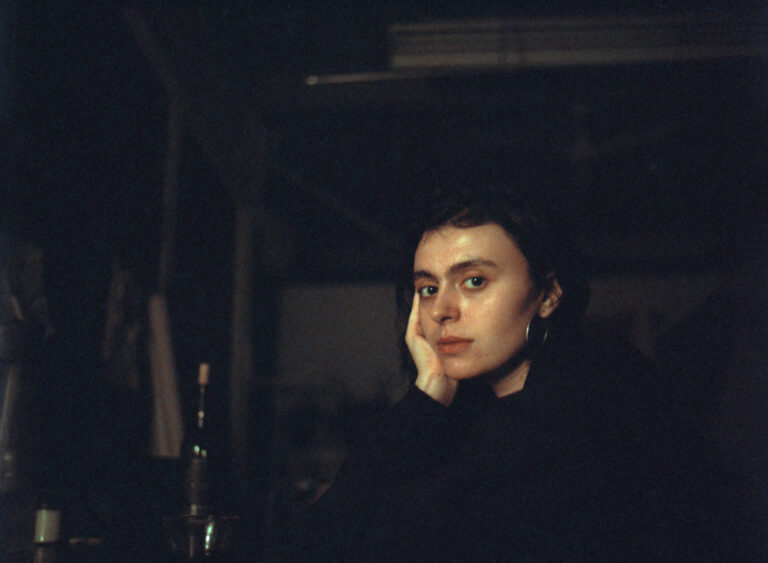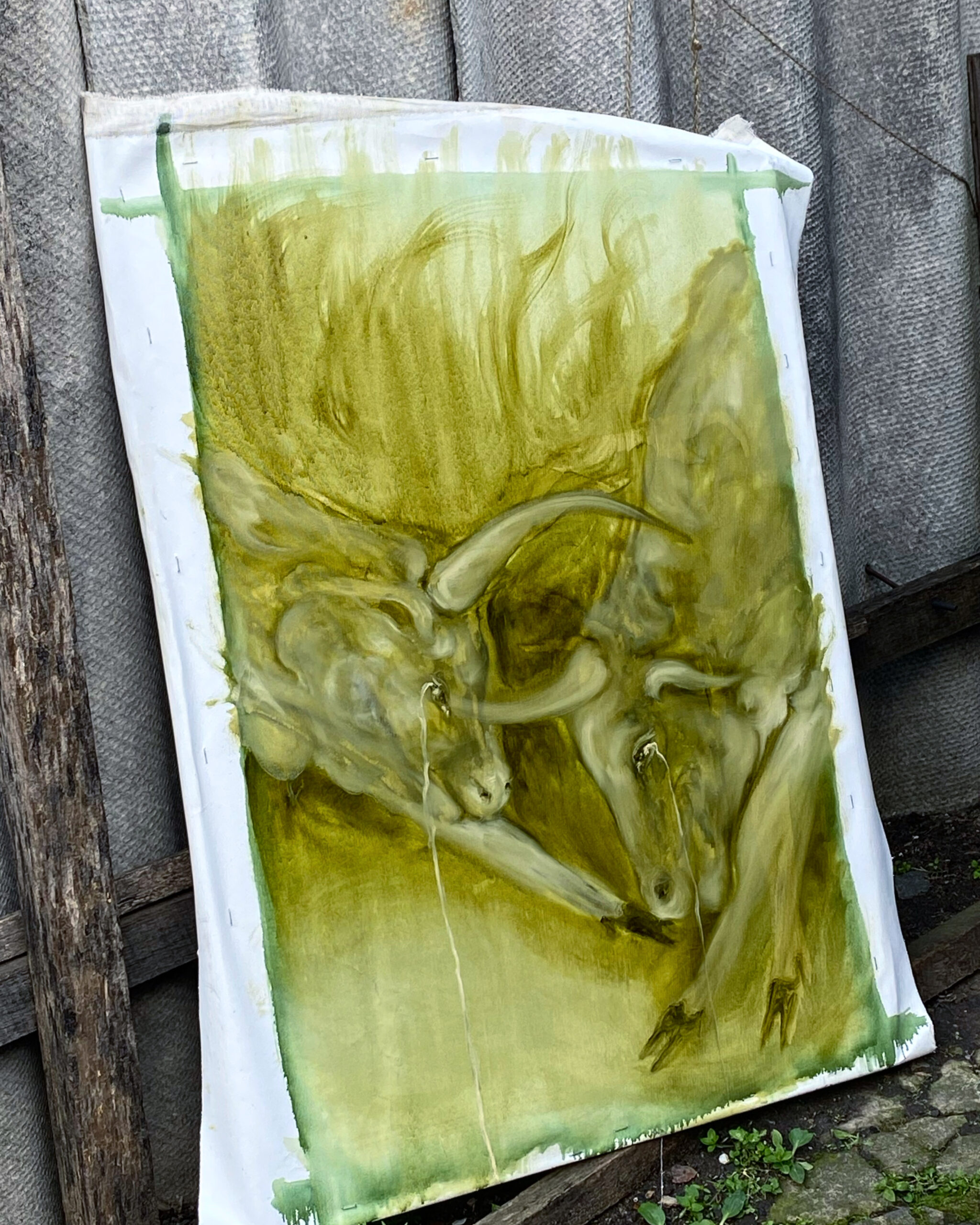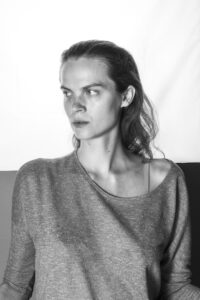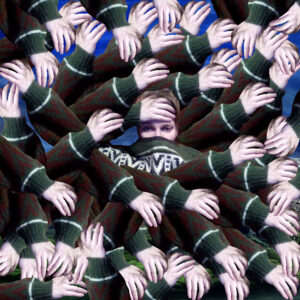Sana Shahmuradova Tanska / Сана Шахмурадова Танська

– born in 1996 in the city of Odesa, Ukraine. Most of her childhood was spent in the village of Podillia in Ukraine. In 2010 she graduated from the school of ballet, and in 2013 she and her family emigrated to Toronto, Canada, where in 2020, she earned her bachelor’s degree of Arts in Psychology at York University. In 2020, Sana Shahmuradova decided to move to Kyiv, where she works in the field of painting and graphics to this day. She uses different materials in her work, such as wood, burlap, canvas, and oil paints. Sana is also exploring her origins and using trauma as a tool to communicate and connect with her ancestors. Her latest works highlight the violence and atrocities that were committed against civilians and nature by the aggressor state (Russia).
Due to the constant retraumatization, the mental gap between generations starts to disappear, and I’m realizing that fate lasts longer than one human life. In the case of my land (Ukraine), very often, the story of one family can showcase the whole historical dynamic of the people of this land in general. The time is rather moving circle-wise than straightforwardly: since Russia’s full-scale war against Ukraine, the generational traumas of the Ukrainian people from the past are coming back to life, and often, the historical scenarios do not change. The aggressor has remained the same for many centuries and uses the same well-known methods from the past. However, despite everything, life in Ukraine continues to go on as it has been for centuries.
So fundamentally, there are no new myths; the old ones are being renewed and are acquiring a fresh meaning, and there is a process of exchange between the ghosts of the past and the future. At the beginning of the full-scale war, as I was horrified by this realization, I created a series of paintings that highlight the cyclical nature of these traumatic events, such as the aggressor’s attempt to conquer our land, genocidal intentions, and mass killings of civilians.
According to my knowledge of different physiological phenomena, intuition is often instant logic. I want to be convinced repeatedly that the conscious and unconscious can coexist as an integral system. If that is the case, then there are certain unknown processes that cannot be fully measured but can be noticed and gasped intuitively. Intuitive conventionality; guessing sometimes leads us to similar answers as the long and conscious searching for the solutions does.
My painting series “Those who survived the apocalypse/ The inhabitants of the Tethys”1 was inspired by the neuropsychological study that claims that the brain’s processes of imagination and remembering are quite similar to each other, and so to imagine, we have to remember first. In my work, I highlight both the history and today’s condition of the southern region of Ukraine, specifically the Black Sea territory. The Black Sea itself has united a lot of crucial periods in the history of Ukraine. And still today, as always, remains a significant strategic point suffering from the major ecological and environmental disaster caused by Russia. I am referring to the research about the Odesa’s catacombs and the district in Odesa where I am originally from. Estuaries and the sea surround this district and have a hidden history that, under a significant influence of colonialist policies, was deliberately ignored and not included in the official writing of the city’s history. For example, the paradoxical phenomenon of limestone, which is constantly being washed away by the sea but can still preserve shells over 6 million years old. The ancient shells and little holes in the limestone remind me of the stories of the inhabitants from the past, which remained under a shadow. The traces of their lives are still present in the limestone dams and caves. I want to believe that some things can still be preserved despite constant destruction.
I am trying to recreate the invisible natural processes behind the formations of unobvious cause-and-effect relationships or movements of the time that cannot be measured. All of these aspects, however, affect the formation of fate and life in different forms. Being concerned about the region’s uncertain future and unspoken past, I put my worries in the polemic about the immeasurable time span from the oldest times of Tethys to a possible future apocalypse. The symbols of the transgenerational traumas are represented in my work: the imaginary inhabitants of the deep sea who carry on the memory of all of the events of the past along with the ability to survive in future catastrophes; the inhabitants of the self-made houses inside of the limestone dams (catacombs) near Kuyalnyk and Hadzhibey, which I created based on a real-life story; the souls of the lovers who survived and the remainings of the spirits that settled in the last trees and fishes on Earth.
The exterminated history of my ancestors and still alive relatives doesn’t stop bothering me. Mainly by the orally told fragments that have come down to me, I am filling the painful void of not knowing about my ancestry and origins. As I’m doing so, I’m remembering Vasyl Stus’2 words: “Instead of the land, our poet has an abyss under his feet. So, half of his efforts are spent on trying to feed the abyss to create a land under his feet”.
The text is written in collaboration with Oksana Briukhovetska (2024).
Notes to the series “Those who survived the apocalypse/ The inhabitants of the Tethys”.
I heard someone talking to me in my dream: “When I want to swim, I fall asleep. I see the water which I seem to be entering, but not quite. Water which I am trying to feel, but can’t. It is forbidden to take pictures in these places. The hills are high. I am trying to enter you water. I am longing for you. I am offering you myself. I try to come to you, but you don’t let me in. Why?”
Later, I heard someone talking to me in the steppe: “It was the era of flying.
And although the body was not adapted for flight, something constantly kept lifting it up.
Now that I have wings, I am forced to crawl on the ground and swallow all the stench that the vile human era leaves behind. I should’ve been flying since I have wings now. But my spirit says that now is the time of the earth. Spirit of the time. Spirit of the land. It is cruel and merciless”.
Salty, salty water made of sweat, tears, and blood. So salty that it leaves burns and eats away the color. And the body is heavy and swollen since it cannot completely get rid of the salt.
This salty water forms the Tethys Ocean inside the body, which does not yet know how its descendant from the next era, the Black Sea, will suffer.
“There, in the web of meanings and names, one will not find the truth”, as the molfar Milentiy from Podillia used to say. The cross on his grave shook because of these words, or perhaps because it simply couldn’t hold itself up in the soil filled with human grief and stench.
Thus, in the confusion, in the web of meanings, a child is born who tastes the deception of sweet lactose with his mother’s milk, because later it turns out that this is the only combination of factors and circumstances when sugar does not harm you, child.
I couldn’t get enough of the “Malysh” porridge, a breakfast alternative for children, after my mom stopped breastfeeding me. I wonder if it was because I was trying to eat for those who couldn’t get enough food, or maybe it’s just that a child shouldn’t be given sugar until the age of 3 so as not to provoke addiction, according to some research.
Wounds that never healed…
Tethys was so long ago that now an attempt to remember it borders with the visualization of a happy future. “To imagine, we must remember,” as one neuropsychological study states (on the similarity of brain activity for both imagining and recalling processes).
Salty Tethys… Was it as salty as the blood soaking through the land of Donbas? Where, by the way, the underwater remains of Tethys were found: Cretaceous rocks of Bilokuzminovka, near Kramatorsk.
I paint the last fish – I am imagining the last fish of Tethys, while thinking about the fish that died after the pollution of the Black Sea.
The retraumatization experienced by the generations of waters, reservoirs, glorious seas and oceans, and the generations of my family as well.
Dedicated to the memory of grandfather Hryhoriy
Translation to English provided by Sana Shahmuradova Tanska.
1Tethys - an ancient gigantic ocean which is often called a sea. There are theories that the Black Sea is the remnants of this ocean.2Vasyl Stus - Ukrainian poet, translator, literary critic, and journalist.
3Image: Sana Shahmuradova Tanska, Snail, Snail, Glister Me Forward (From “The Lost Son”, 1948, by Theodore Roethke), oil on canvas, 120x130 cm, 2024. Courtesy of the artist.
4Image: Sana Shahmuradova Tanska, Living, dead, and yet unborn (from “To my fellow-countrymen, in Ukraine and not in Ukraine, living, dead, and as yet unborn, my friendly epistle”, Taras Shevchenko, 1845, oil on canvas, 2024. Courtesy of the artist.
5Image: Sana Shahmuradova Tanska, Too bitter we cried abused nature we loved too fiercely our lovers shame (*from “We’ll not die in Paris”, poem by Natalka Bilotserkivets), diptych, oil on canvas, 2023. Courtesy of the artist.
6Image: Sana Shahmuradova Tanska, Too bitter we cried abused nature we loved too fiercely our lovers shame (from “We’ll not die in Paris”, poem by Natalka Bilotserkivets), diptych, oil on canvas, 2023. Courtesy of the artist.
7Image: Sana Shahmuradova Tanska, Neither mother’s nor father’s, raised outdoors, laid in an egg by a bird (Saying describing the soviet politics of destruction), oil on canvas, 2023. Courtesy of the artist.
8Image: Sana Shahmuradova Tanska, Diptych from “Apocalypse survivors or Tethys sea inhabitants” series: Tethys sea inside me, 130x120cm, oil on canvas, 2023. Courtesy of the artist.
9Image: Sana Shahmuradova Tanska, Diptych from “Apocalypse survivors or Tethys sea inhabitants” series: Apocalypse survivors: a mussel, two loving souls, a fish, 130x120cm, 2023. Courtesy of the artist.
10Image: Sana Shahmuradova Tanska, “Apocalypse survivors or Tethys sea inhabitants” series, oil on canvas, 140x150 cm, 2023. Courtesy of the artist.
11Image: Sana Shahmuradova Tanska, Limestone’s memories, from “Apocalypse survivors or Tethys sea inhabitants”, 200x160cm, 2023. Courtesy of the artist.
12Image: Sana Shahmuradova Tanska, “Apocalypse survivors or Tethys sea inhabitants” series, oil on found wood, 2023. Courtesy of the artist.
13Image: Sana Shahmuradova Tanska, “Apocalypse survivors or Tethys sea inhabitants” series, oil on found wood, 2023. Courtesy of the artist.
14Image: Sana Shahmuradova Tanska, Houses of honesty and mystery (*from “Seems So Long Ago”, Nancy, 1969, poem by Leonard Cohen), ghosts of past and future, oil on canvas, 2023. Courtesy of the artist.
15Image: Sana Shahmuradova Tanska, Tears insteaf of Milk, from “Retraumatization series”, oil on canvas, 80x70cm, 2022. Courtesy of the artist.
16Image: Sana Shahmuradova Tanska, Delayed Sowing, from “Retraumatization series”, 130x120cm, 2022. Courtesy of the artist.
17Image: Sana Shahmuradova Tanska, To the very first Ukrainian novel I read, "Do the oxen low/roar when the manger is full" by Panas Myrny; at that moment the air alarm siren was roaring, oil on canvas, 96x68 cm, 2022. Courtesy of the artist.
– народилася 1996 року в Одесі, Україна. Значна частина її дитинства пройшла в селі на Поділлі в Україні. У 2010 році закінчила балетну школу, а в 2013 році її родина іммігрувала до Торонто, Канада, де в 2020 році вона отримала ступінь бакалавра мистецтв із психології в Йорк університеті. У 2020 році вирішила переїхати до Києва, де продовжує працювати з живописом та графікою, використовуючи різні поверхні – дерево, мішковина, полотно та олійні фарби. Досліджує своє походження, використовуючи травму як метод спілкування з предками. Останні її роботи висвітлюють звірства та наругу над природою та мешканцями, вчинені агресором
Через ретравматизацію дистанція між поколіннями зникає, і я усвідомлюю, що доля триває довше за одне людське життя. У випадку моєї землі, часто одна сімейна історія показує історичну динаміку народу в цілому. Час рухається по колу, а не лінійно: із повномасштабним вторгненням в Україні оживають травми поколінь, а каркасні сценарії історії не змінюються. Агресор зі століття в століття той самий, і використовує впізнавані інструменти та методи. Та попри все, життя в Україні триває, й вже не перше століття.
Отже, принципово нових міфів немає, старі оновлюються і набувають свіжої оболонки, відбувається обмін привидами минулого і майбутнього. На початку повномасштабного вторгення, шокована від усвідомлення цього, я створила низку робіт, що висвітлюють циклічність травматичних подій, таких як зазіхання агресора на наші жнива, творення геноцидних обставин, масові вбивства.
Згідно з деякими моїми знаннями про психологічні феномени, інтуїція часто є швидкою логікою. Мені хочеться впевнитись знову й знову, що свідомість та несвідоме рівноправно співіснують як цілісний механізм. Якщо це так, то є невідомі процеси, які наче й не можна виміряти, але можна схопити інтуїтивно. Інтуїтивна умовність, вгадування деколи ведуть до схожих відповідей, що й довгі та свідомі пошуки рішення.
Моя серія “Ті, що пережили апокаліпсис / Мешканці Тетісу”1 навіяна роздумами про нейропсихологічне дослідження, яке стверджує, що мозкова активність процесів уяви та згадування схожі між собою, і отже, щоб уявити, ми повинні пам’ятати. У моїй роботі я торкаюся історії і теперішнього стану південного регіону України, зокрема території Чорного моря. Чорне море об’єднало в собі багато вирішальних історичних періодів України, і сьогодні, як і завжди, є дуже важливим стратегічно, потерпаючи також від великого екологічного удару агресора. Я звертаюся до дослідження про Одеські катакомби та район Одеси, звідки я родом. Він оточений лиманами та морем, і має приховану історію, яку проігнорували при написанні офіційної історії міста під великим впливом колонізаторських політик. Наприклад, парадоксальний феномен вапняку, що постійно вимивається морем, але все одно зберігає в собі мушлі віком 6 мільйонів років. Древні мушлі й дрібні дірочки у вапнякові нагадують історії мешканців минулого, які залишились в тіні. Сліди їхнього життя присутні у вапнякових дамбах і печерах. Хочу вірити, що щось може зберегтися попри постійне знищення.
Я намагаюся відтворити невидимі природні процеси, що стоять за формуванням неочевидних причинно-наслідкових зв’язків, або за рухом часу, який не можна виміряти. Усе це втім впливає на формування долі й життя у багатьох проявах. Переймаючись хитким майбутнім та непроговореним минулим регіону, я загортаю свої переживання у полеміку щодо неосяжного часового відрізку від найдавнішого минулого часів Тетісу до можливого майбутнього Апокаліпсису. У роботах представлені символи трансгенераційних травм: уявні мешканці глибокого моря, які несуть пам’ять про всі минулі події разом зі здатністю виживати у майбутніх катастрофах; мешканці саморобних будиночків всередині вапнякових дамб (катакомб) поблизу Куяльника та Гаджибею, яких я створила на основі реальної історії; душі коханців, що вижили, та залишки духів, що оселилися в останніх на землі деревах та рибах.
Винищена історія моїх предків та досі живих родичів не полишає мене у спокої. Зі здебільшого усних фрагментів, що все ж дійшли до мене, я заповнюю болючу пустоту незнання про своє походження. І тут пригадую слова Стуса2: “Замість материка наш поет має під ногами прірву. Отож, половина його зусиль іде на те, щоб нагодувати прірву, щоб створити материк під ногами”.
Текст написаний у співпраці з Оксаною Брюховецькою (2024).
Нотатки до серії робіт ‘Ті, що пережили апокаліпсис / Мешканці Тетісу’
Хтось заговорив до мене уві сні: “Коли я хочу плавати – я засинаю. Я бачу воду, в яку я ніби заходжу, але й ні, яку я ніби відчуваю, але насправді не можу відчути. Тут, в цих місцях, заборонено фотографувати. Горби високі. Я намагаюсь зайти до тебе, але ти мене не пускаєш. Чому?”
Пізніше хтось заговорив до мене в степу: “То була ера літання. І хоча тіло було непристосоване для польоту, щось постійно підносило його. Тепер, коли я маю крила, я вимушена повзати землею і ковтати разом із нею весь сморід, що лишає за собою паскудна ера людини. Я мала би літати, бо маю крила тепер. Але дух мій каже, що зараз час землі. Дух часу. Дух землі. Він суворий і нещадний”.
Солона солона вода з поту, сліз та крові, така солона, що залишає після себе опіки та виїдає колір. А тіло важке та опухле через те, що не може до кінця позбавитися від неї.
Ця солона вода утворює океан Тетіс всередині тіла. Він ще не знає, як страждатиме його нащадок із наступної ери – Чорне море.
Там, у павутинні сенсів та назв, не знайти буде правди, як казав мольфар Мілентій з Поділля. На його могилі похитнувся хрест через ці слова, а може від того, що просто фізично не втримав себе у ґрунті, забитому людським горем та смородом.
Так у плутанині, у павутинні сенсів народжується дитя, що із молоком матері куштує обман із солодкою лактозою, бо згодом виявиться, що це така собі єдина комбінація чинників і обставин, коли цукор ще тобі не нашкодить, дитино. Я аж ніяк не могла напитись цією кашею “малиш” після того, як мама вже не годувала мене груддю. Бо я намагалася доїсти за тих, що не доїли колись. Чи може просто дитині не треба давати цукор до 3-х років, аби не спровокувати залежність (так запевняє якесь-там дослідження).
Рани, що ніколи не загоїлися. Тетіс був так давно, що тепер уява про нього межує з уявою про щасливе майбутнє. «Щоб уявити, ми повинні пам’ятати», як стверджує одна нейропсихологічне дослідження про подібність мозкової активності процесів уяви та пригадування.
Солоний Тетіс як кров, що тепер замінює його на Сході України, де були знайдені підводні залишки Тетісу – крейдяні Білокузьминівські скелі під Краматорськом.
Малюю останню рибку – уявляю останню рибку Тетісу, думаючи про рибку, що вмерла після забруднення Чорного моря.”
Присвячено пам’яті дідуся Григорія
1Тетіс - давній гігантський океан, який часто називають морем. Вважається, що Чорне море - це залишки цього океану.2Василь Стус - украинский поет, перекладач, літературний критик, журналіст.
3Зображення: Сана Шахмурадова Танська, Snail, Snail, Glister Me Forward (з поеми “The Lost Son” 1946, Теодор Рьотке), полотно, олія, 2024. Надано художницею.
4Зображення: Сана Шахмурадова Танська, І мертві, і живі, і ненароджені (З “І мертвим і живим” Тараса Шевченко, 1845), полотно, олія, 2024. Надано художницею.
5Зображення: Сана Шахмурадова Танська, Надто гірко ми плакали і ображали природу, надто сильно любили коханців соромлячи тим (з поезії “Ми помрем не в Парижі” Наталки Білоцерківець), диптих, полотно, олія, 2023. Надано художницею.
6Зображення: Сана Шахмурадова Танська, Надто гірко ми плакали і ображали природу, надто сильно любили коханців соромлячи тим (з поезії “Ми помрем не в Парижі” Наталки Білоцерківець), диптих, полотно, олія, 2023. Надано художницею.
7Зображення: Сана Шахмурадова Танська, Не татова не мамина, на вулиці росла, пташка знесла (Вислів що описує радянську політику знищення), полотно, олія, 2023. Надано художницею.
8Зображення: Сана Шахмурадова Танська, Диптих з серії “Ті, що пережили апокаліпсис/Мешканці Тетісу”, Море Тетіс усередині мене, полотно, олія, 130x120см, 2023. Надано художницею.
9Зображення: Сана Шахмурадова Танська, Диптих з серії “Ті, що пережили апокаліпсис/Мешканці Тетісу”, Ті, що пережили апокаліпсис: мідія, дві закохані душі, риба, 130x120 см, 2023. Надано художницею.
10Зображення: Сана Шахмурадова Танська, З серії “Ті, що пережили апокаліпсис/Мешканці Тетісу”, 140x150 cм, 2023. Надано художницею.
11Зображення: Сана Шахмурадова Танська, Cпогади впняка, з серії “Ті, що пережили апокаліпсис/Мешканці Тетісу”, 200x160 cm, 2023. Надано художницею.
12Зображення: Сана Шахмурадова Танська, З серії “Ті, що пережили апокаліпсис/Мешканці Тетісу”, олія на знайдених деревʼяних обʼєктах, 2023. Надано художницею.
13Зображення: Сана Шахмурадова Танська, З серії “Ті, що пережили апокаліпсис/Мешканці Тетісу”, олія на знайдених деревʼяних обʼєктах, 2023. Надано художницею.
14Зображення: Сана Шахмурадова Танська, Houses of honesty and mystery (з поезії Леонарда Коена “Seems So Long Ago”, Nancy, 1969, примари минулого і майбутнього), полотно, олія, 2023. Надано художницею.
15Зображення: Сана Шахмурадова Танська, Сльози замість молока, Присвячується моїм двоюрідним дідусям, що померли новонародженими дітьми під час Голодомору, полотно, олія, 80x70cм, 2022. Надано художницею.
16Зображення: Сана Шахмурадова Танська, Затримка посівної через геноцид з серії “Ретравматизація”, полотно олія, 110x120 cм, 2022. Надано художницею.
17Зображення: Сана Шахмурадова Танська, Найпершому українському роману, який я прочитала, “Хіба ревуть воли як ясла повні” Панаса Мирного; в цей момент вила сирена повітряної тривоги, полотно олія, 96x68cм, 2023. Надано художницею.



